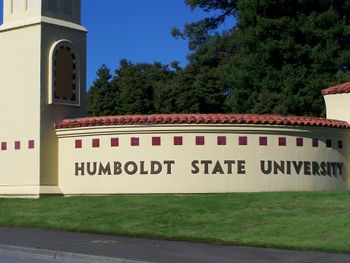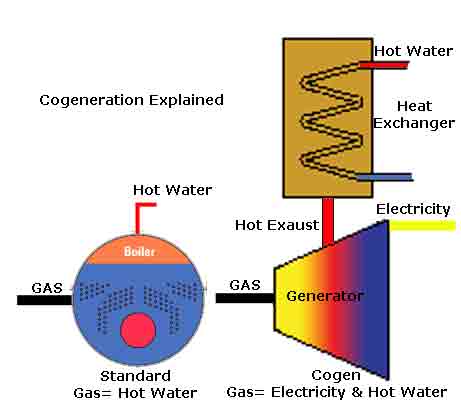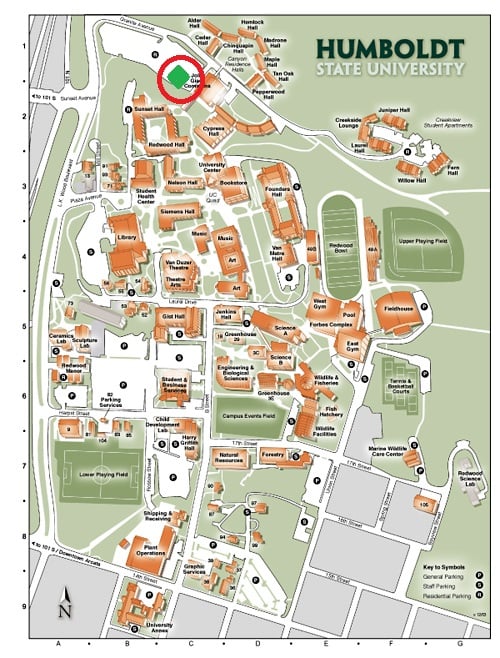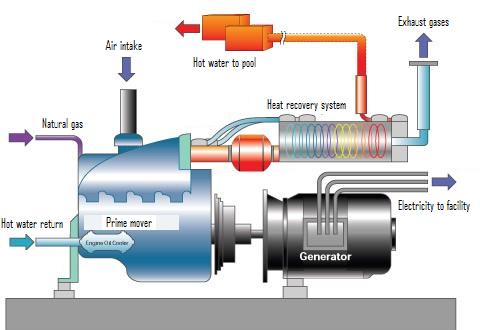Lily Brook (talk | contribs) |
|||
| (46 intermediate revisions by 6 users not shown) | |||
| Line 1: | Line 1: | ||
{{ | {{TOC right}} [[Image:Cfiles35725.jpg|left|350px]] | ||
= The History of CoGeneration = | = The History of CoGeneration = | ||
Energy cogeneration has had a long and interesting history that lead up to | Energy [[cogeneration]] has had a long and interesting history that has lead up to technologies we use today. Cogeneration technology was developed in the early twentieth century, when people realized that steam power(primary power source then),could simultaneously produce electricity<ref>"Cogeneration - History Of Cogeneration". Science Encyclopedia. &amp;amp;amp;amp;lt;http://science.jrank.org/pages/1572/Cogeneration-History-cogeneration.html&amp;amp;amp;amp;gt;.</ref>. From 1940 on, the technology was steadily used for industry, and eventually branched out into residential uses, but has never really reached its full capacity in terms of use. Since its earliest days, engineers have experimented with different combinations of energy forms produced, while utilizing various types of fuels to power these systems.(see Table 1) This technology is often referred to, as Combined Heat and Power, or CHP. It is strongly advocated by the EPA<ref>U.S. Environmental Protection Agency. &amp;amp;amp;amp;lt;http://www.epa.gov/&amp;amp;amp;amp;gt;.</ref>, because of its increased operational efficiency, lower energy costs, and reduced demand on our natural resources. The CHPP<ref>"Combined Heat and Power Partnership". U.S. Environmental Protection Agency. &amp;amp;amp;amp;lt;http://www.epa.gov/chp/&amp;amp;amp;amp;gt;.</ref>, or Combined Heat and Power Partnership, is an organization that encourages the use of CHP Technologies and is very supportive of the transition from conventional systems over to CHP<ref>"Archive for the ‘cogeneration’ Category". Carbonetix. &amp;amp;amp;lt;http://carbonetix.com.au/ &amp;amp;amp;gt;.</ref>, and [http://www.epa.gov/chp/ their website] is very helpful and informative for anybody interested in this technology. | ||
[[Image:Cogen.jpg|frame|left|461x403px|Figure 1. This Cogeneration unit shows how a boiler can be used to make hot water and power a generator, which in turn creates electricity and heating.]] | [[Image:Cogen.jpg|frame|left|461x403px|Figure 1. This Cogeneration unit shows how a boiler can be used to make hot water and power a generator, which in turn creates electricity and heating.]] | ||
<br> | <br> | ||
{| style="width: 288px; height: 202px" border="1" cellspacing="1" cellpadding="1" align="left" | {| style="width: 288px; height: 202px" border="1" cellspacing="1" cellpadding="1" align="left" | ||
|Table 1 | |||
|- | |- | ||
| | | | ||
| Line 19: | Line 20: | ||
|- | |- | ||
| | | heating + electricity | ||
| Diesel Fuel | | Diesel Fuel | ||
|- | |- | ||
| | | heating | ||
| Waste Vegetable Oil''<sup></sup> Veggawatt*'' <ref>"Archive for the ‘cogeneration’ Category". Carbonetix. &amp;amp;amp;amp;lt;http://carbonetix.com.au/ &amp;amp;amp;amp;gt;.</ref> | | Waste Vegetable Oil''<sup></sup> Veggawatt*'' <ref>"Archive for the ‘cogeneration’ Category". Carbonetix. &amp;amp;amp;amp;lt;http://carbonetix.com.au/ &amp;amp;amp;amp;gt;.</ref> | ||
|- | |- | ||
| | | heating + electricity | ||
| Steam | | Steam | ||
|- | |- | ||
| | | heating + electricity | ||
| Coal | | Coal | ||
|- | |- | ||
| | | hot water + ambient heat '''( H.S.U.)''' | ||
| Natural Gas | | Natural Gas | ||
|} | |} | ||
| Line 57: | Line 58: | ||
= Cogeneration at Humboldt State = | = Cogeneration at Humboldt State = | ||
The cogeneration building is located in the front parking lot of the Jolly Giant Commons(JGC)(Figure 2). This building often has a few service vehicles outside and is closer to the | The cogeneration building is located in the front parking lot of the Jolly Giant Commons(JGC)(Figure 2). This building often has a few service vehicles outside and is closer to the forest wall on the left of the parking lot when looking at it from the road. After talking with a few HSU staff members, we tracked down the Maintenance Supervisor (housing and dining services) here at HSU, Tim Freeman, who kindly gave us a tour of the cogeneration system present here,on campus. Tim also provided us with useful information on how Cogeneration works. [[Image:HSU map.jpg|frame|right|430x500px| Figure 2. Where the cogeneration plant is on the Humboldt Campus]] | ||
<br> The cogeneration | <br> The cogeneration Unit runs 24/7, and has been since its installation in 1987 Unlike the majority of other cogeneration facilities serving different functions, the system here at Humboldt produces hot water and ambient heating instead of heating and energy production. This system supports a majority of residence halls, here on campus, with on demand hot water and ambient room heating, for students. The cogeneration unit is constantly producing around 350KW (350,000 Watts), and all of the hot water, heat and energy produced on campus is used on campus. Under every residence hall that this system covers, is a boiler and a heating unit, except Canyon, which only has air heating units. These boilers were set in place when the halls were made but since the cogeneration unit's construction, they are not being used. | ||
| These older boilers under the halls are only used when the system for some reason doesn't work (which is near never).<br> | ||
== The Distribution Loop at Humboldt == | == The Distribution Loop at Humboldt == | ||
[[Image:Cogen diagram.jpg|frame|right| | [[Image:Cogen diagram.jpg|frame|right|300px|Figure 3. This image portrays a similar system to that of HSU's, where returning water,is put back through the "loop", until it is used.<ref>"Archive for the ‘cogeneration’ Category". Carbonetix. <http://carbonetix.com.au/ >.</ref>]]The process starts with the engine heating up a series of stainless steel "heating" plates, which are exposed to a water distribution loop. The high temperature water then circulates uphill, to the Redwood and Sunset residence halls.(Because the water comes out of the engine so hot there is a cooling mechanism that remixes the hot and cold water, to accommodate appropriate temperatures for showers and kitchen utility. From there, the loop continues down the hill through the Jolly Giant Commons, building. There, it provides hot water for the dishwasher (180<sup>o</sup>F.) and all other domestic systems running through the building. The line then splits in two, one going to the east(starts at Pepperwood) and west(starts at Cedar) sides of the Canyon dormitories. Due to the fact that the circulatory system was poorly thought out, there is no way to release any excess heat that ends up at the end of the line here, so the two end buildings on the east and west side are unable to dissipate the excess heat, making them the hottest buildings on campus. It then completes the loop, recycling back to the cogeneration building (at 120F. or greater) in the JGC parking lot to be heated back up. This system (shown in Figure 3) describes our campus cogeneration system, here on campus. The Engine creates power(thermal heat), which consequently heats and reheats water, constantly circulating within a closed loop network.(don't worry, waste water from showers and toilets are not connected to this system). | ||
== Other Information<br> == | == Other Information<br> == | ||
| Line 75: | Line 76: | ||
== Known Issues With Our Unit Here On Campus<br> == | == Known Issues With Our Unit Here On Campus<br> == | ||
*The entire system is directly connected and there is no isolating any part of the system, which means that when one part of the system goes down, the rest is affected. | *The entire system is directly connected and there is no way of isolating any part of the system, which means that when one part of the system goes down, the rest is affected. | ||
*The heating distribution among the Canyon buildings was poorly made, | *The heating distribution among the Canyon buildings was poorly made, resulting in two of the buildings being constantly heated because there is no ventilation for excess heat. | ||
*Because there is extremely hot water coming straight out of the co-gen plant, the engineers had to add a cooling system so that the water that went into the buildings could be used for showering.<br> | *Because there is extremely hot water coming straight out of the co-gen plant, the engineers had to add a cooling system so that the water that went into the buildings could be used for showering.<br> | ||
== Another CoGen system here on campus | == Another CoGen system here on campus<br> == | ||
During an interview with Tim, he mentioned Humboldt also has a useless 700,000 dollar cogeneration unit in place, adjacent to the newer gymns. Tim continued to iterate that the reason behind the systems dysfunction, was due to the company that was hired to install the infrastructure, failing to configure it correctly. This resulted in a faulty regulation system, which overworked the engine, burning it out. Mr. Freeman continued to iterate that due to ongoing budget challenges, there is little incentive to address the system, at this time. | |||
= See Also = | = See Also = | ||
[ | [[HSU Forbes Complex Cogeneration]] | ||
| | ||
[http://en.wikipedia.org/wiki/Cogeneration Wikipedia - Cogeneration] | [http://en.wikipedia.org/wiki/Cogeneration Wikipedia - Cogeneration] | ||
= References = | = References = | ||
<references /> | <references /> | ||
Freeman, Tim. Personal INTERVIEW. | |||
[[Category:Cogeneration]] | |||
[[Category:Energy]] | |||
Revision as of 22:57, 26 November 2013

The History of CoGeneration
Energy cogeneration has had a long and interesting history that has lead up to technologies we use today. Cogeneration technology was developed in the early twentieth century, when people realized that steam power(primary power source then),could simultaneously produce electricity[1]. From 1940 on, the technology was steadily used for industry, and eventually branched out into residential uses, but has never really reached its full capacity in terms of use. Since its earliest days, engineers have experimented with different combinations of energy forms produced, while utilizing various types of fuels to power these systems.(see Table 1) This technology is often referred to, as Combined Heat and Power, or CHP. It is strongly advocated by the EPA[2], because of its increased operational efficiency, lower energy costs, and reduced demand on our natural resources. The CHPP[3], or Combined Heat and Power Partnership, is an organization that encourages the use of CHP Technologies and is very supportive of the transition from conventional systems over to CHP[4], and their website is very helpful and informative for anybody interested in this technology.

| Table 1 | |
|
Cogeneration produces |
Fuels to be used |
| heating + electricity | Diesel Fuel |
| heating | Waste Vegetable Oil Veggawatt* [5] |
| heating + electricity | Steam |
| heating + electricity | Coal |
| hot water + ambient heat ( H.S.U.) | Natural Gas |
Cogeneration at Humboldt State
The cogeneration building is located in the front parking lot of the Jolly Giant Commons(JGC)(Figure 2). This building often has a few service vehicles outside and is closer to the forest wall on the left of the parking lot when looking at it from the road. After talking with a few HSU staff members, we tracked down the Maintenance Supervisor (housing and dining services) here at HSU, Tim Freeman, who kindly gave us a tour of the cogeneration system present here,on campus. Tim also provided us with useful information on how Cogeneration works.

The cogeneration Unit runs 24/7, and has been since its installation in 1987 Unlike the majority of other cogeneration facilities serving different functions, the system here at Humboldt produces hot water and ambient heating instead of heating and energy production. This system supports a majority of residence halls, here on campus, with on demand hot water and ambient room heating, for students. The cogeneration unit is constantly producing around 350KW (350,000 Watts), and all of the hot water, heat and energy produced on campus is used on campus. Under every residence hall that this system covers, is a boiler and a heating unit, except Canyon, which only has air heating units. These boilers were set in place when the halls were made but since the cogeneration unit's construction, they are not being used.
These older boilers under the halls are only used when the system for some reason doesn't work (which is near never).
The Distribution Loop at Humboldt

The process starts with the engine heating up a series of stainless steel "heating" plates, which are exposed to a water distribution loop. The high temperature water then circulates uphill, to the Redwood and Sunset residence halls.(Because the water comes out of the engine so hot there is a cooling mechanism that remixes the hot and cold water, to accommodate appropriate temperatures for showers and kitchen utility. From there, the loop continues down the hill through the Jolly Giant Commons, building. There, it provides hot water for the dishwasher (180oF.) and all other domestic systems running through the building. The line then splits in two, one going to the east(starts at Pepperwood) and west(starts at Cedar) sides of the Canyon dormitories. Due to the fact that the circulatory system was poorly thought out, there is no way to release any excess heat that ends up at the end of the line here, so the two end buildings on the east and west side are unable to dissipate the excess heat, making them the hottest buildings on campus. It then completes the loop, recycling back to the cogeneration building (at 120F. or greater) in the JGC parking lot to be heated back up. This system (shown in Figure 3) describes our campus cogeneration system, here on campus. The Engine creates power(thermal heat), which consequently heats and reheats water, constantly circulating within a closed loop network.(don't worry, waste water from showers and toilets are not connected to this system).
Other Information
- The cogen motor responsible for heating and transporting water through the arterial network, runs on natural gas purchased from PG&E on a monthly bid contract. (Calculating just the right amount of fuel needed per month ensures the best contract price per billing cycle.
- This system has an alarm 'call' system, which, when the system has an issue, it contacts Tim Freeman(head of HSU maintenance), who then calls in one of his workers to either check out the issue or fix whatever has happened.
- It is mandatory that the engine is removed from the Cogeneration building to be cleaned, lubricated, and checked every fourteen years.
Known Issues With Our Unit Here On Campus
- The entire system is directly connected and there is no way of isolating any part of the system, which means that when one part of the system goes down, the rest is affected.
- The heating distribution among the Canyon buildings was poorly made, resulting in two of the buildings being constantly heated because there is no ventilation for excess heat.
- Because there is extremely hot water coming straight out of the co-gen plant, the engineers had to add a cooling system so that the water that went into the buildings could be used for showering.
Another CoGen system here on campus
During an interview with Tim, he mentioned Humboldt also has a useless 700,000 dollar cogeneration unit in place, adjacent to the newer gymns. Tim continued to iterate that the reason behind the systems dysfunction, was due to the company that was hired to install the infrastructure, failing to configure it correctly. This resulted in a faulty regulation system, which overworked the engine, burning it out. Mr. Freeman continued to iterate that due to ongoing budget challenges, there is little incentive to address the system, at this time.
See Also
HSU Forbes Complex Cogeneration
References
- ↑ "Cogeneration - History Of Cogeneration". Science Encyclopedia. &amp;amp;amp;lt;http://science.jrank.org/pages/1572/Cogeneration-History-cogeneration.html&amp;amp;amp;gt;.
- ↑ U.S. Environmental Protection Agency. &amp;amp;amp;lt;http://www.epa.gov/&amp;amp;amp;gt;.
- ↑ "Combined Heat and Power Partnership". U.S. Environmental Protection Agency. &amp;amp;amp;lt;http://www.epa.gov/chp/&amp;amp;amp;gt;.
- ↑ "Archive for the ‘cogeneration’ Category". Carbonetix. &amp;amp;lt;http://carbonetix.com.au/ &amp;amp;gt;.
- ↑ "Archive for the ‘cogeneration’ Category". Carbonetix. &amp;amp;amp;lt;http://carbonetix.com.au/ &amp;amp;amp;gt;.
- ↑ "Archive for the ‘cogeneration’ Category". Carbonetix. <http://carbonetix.com.au/ >.
Freeman, Tim. Personal INTERVIEW.